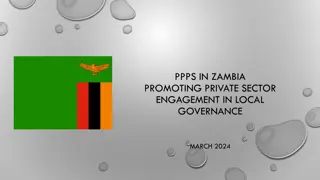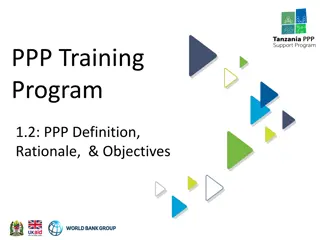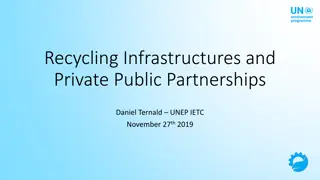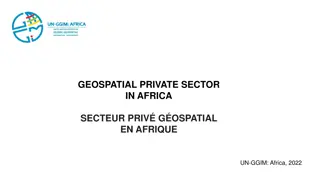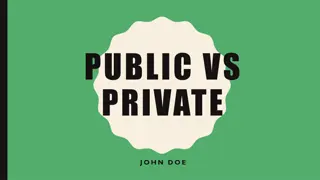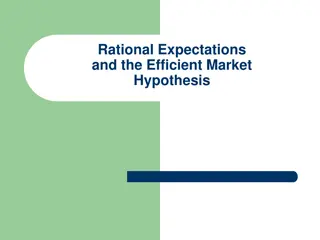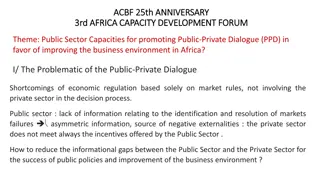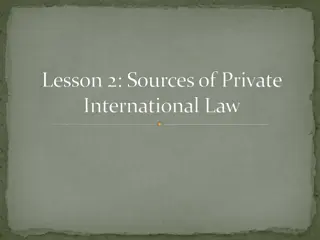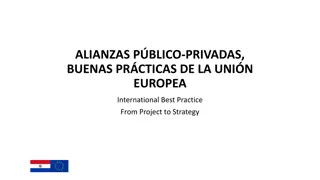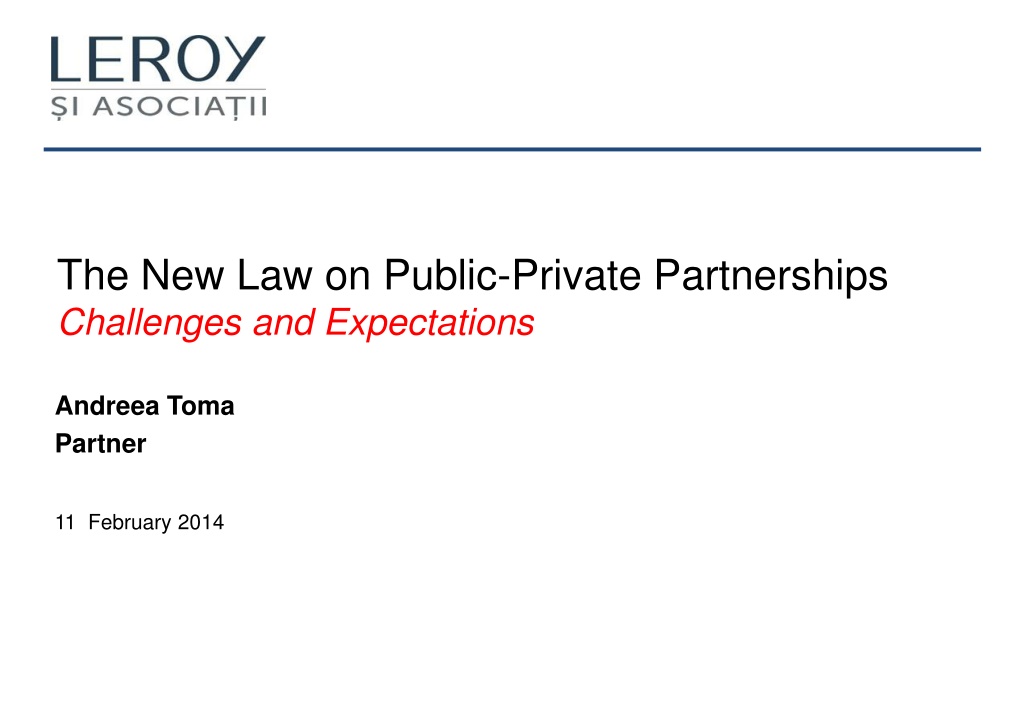
New Law on Public-Private Partnerships in Romania
The article discusses the challenges and expectations surrounding the new law on public-private partnerships in Romania, highlighting the legislative context, flaws in the current legal framework, and the status of the new PPP law's legislative process. It provides insights into the evolution of PPP regulations in Romania and the proposed changes to enhance the partnership structure.
Download Presentation

Please find below an Image/Link to download the presentation.
The content on the website is provided AS IS for your information and personal use only. It may not be sold, licensed, or shared on other websites without obtaining consent from the author. If you encounter any issues during the download, it is possible that the publisher has removed the file from their server.
You are allowed to download the files provided on this website for personal or commercial use, subject to the condition that they are used lawfully. All files are the property of their respective owners.
The content on the website is provided AS IS for your information and personal use only. It may not be sold, licensed, or shared on other websites without obtaining consent from the author.
E N D
Presentation Transcript
The New Law on Public-Private Partnerships Challenges and Expectations Andreea Toma Partner 11 February 2014
Outline 1. The Legislative Context of PPPs in Romania 2. The New PPP Law What s New? The New Law on Public-Private Partnerships Challenges and Expectations | 11 February 2014 | 2
1.The Legislative Context of PPPs in Romania The New Law on Public-Private Partnerships Challenges and Expectations | 11 February 2014 | 3
Current PPP Legal Framework First attempt to regulate PPPs: Government Ordinance no. 16/2002 on the public-private partnership contracts repealed in 2006 (non compliance with EU Law) Current legal framework: Law no. 178/2010 on public-private partnerships (to be repealed by the New PPP Law) Methodological Norms for the implementation of Law no. 178/2010, approved by Government Decision no. 1239/2010 The New Law on Public-Private Partnerships Challenges and Expectations | 11 February 2014 | 4
Conceptual flaws in Law no. 178/2010 No possibility for the public partner to offer guarantees or financial contribution to the project The PPP Law only provides for an in-kind contribution of the public partner to the project company No clear definition of the boundaries and scope of application: of the Law no. 178/2010 and of the concessions legal framework (consisting mainly of GEO no. 34/2006 on the award of public procurement contracts and public works and services concessions contracts and of GD no. 71/2007 approving the norms for the implementation of GEO 34/2006) No mechanisms designed to secure the rights of the creditors financing the project (no direct agreement, no step-in right) The New Law on Public-Private Partnerships Challenges and Expectations | 11 February 2014 | 5
New PPP Law - Status of Legislative Process The Government of Romania initiates the draft bill on public-private partnerships New PPP Law on 26 September 2013 The New PPP Law is approved by the Romanian Parliament on 17 December 2013 and is sent to the President for promulgation on 23 December 2013 On 13 January 2014, the President of Romania requests the re-examination of the New PPP Law On 10 February 2014, the Senaterejects the re-examination request The re-examination request is currently pending before the Chamber of Deputies The New Law on Public-Private Partnerships Challenges and Expectations | 11 February 2014 | 6
New PPP Law vs. Current PPP Legal Framework Relationship with the existing legal framework: Repeals Law no. 178/2010 on public-private partnerships Co-exists with the concessions legal framework (GEO no. 34/2006 on the award of public procurement contracts, public works concession contracts and services concession contracts and GD no. 71/2007 approving the norms for the implementation of GEO 34/2006) The New Law on Public-Private Partnerships Challenges and Expectations | 11 February 2014 | 7
2.The New PPP Law Whats New? The New Law on Public-Private Partnerships Challenges and Expectations | 11 February 2014 | 8
Types of Projects to be Implemented Projects to be implemented under a public-private partnership structure: construction, rehabilitation and/or extension of assets purported to be used for the supply and/or operation of a public service Difference between PPPs and concessions (in line with Eurostat principles): PPP all or majority of revenues of the SPV = payments made by the public partner( availability payments ) (New PPP Law) Concession (GEO no. 34/2006 & GD no. 71/2007) all or majority of revenues of the SPV = tariffs paid by the users of the asset/public service ( tolls ) The New Law on Public-Private Partnerships Challenges and Expectations | 11 February 2014 | 9
Financing PPP projects (1/2) Financing sources depending on the project phase: Sources of Financing Project phase Private Funds EU Funds Public Funds Yes Yes, if available No Construction (investment) Yes Yes, if available Yes Operation and maintenance The New Law on Public-Private Partnerships Challenges and Expectations | 11 February 2014 | 10
Financing PPP projects (2/2) Contributions by the public partner to the project: creating certain rights in favour of the SPV/private partner cash contributions to the share capital of the SPV undertaking payment obligations towards the SPV/private partner guarantees in favour of the lenders (credit or finance institutions) During the operation and maintenance phase, the public partner is allowed to make availability payments to the SPV Cash-flow of the SPV: availability payments, or availability payments plus tariffs paid by end-users The New Law on Public-Private Partnerships Challenges and Expectations | 11 February 2014 | 11
Security Interests The types of available security interests are described in Article 16 of the New PPP Law: (1) The private partner or, as the case may be, the project company, may establish security on receivables and rights held on the basis of the public-private partnership contract, exclusively in favour of the lenders of the public-private partnership project which are credit institutions or other financial institutions and only for the term of the public-private partnership contract. (2) The private partner may set up security interests over the shares held in the project company exclusively in favour of the lenders of the public-private partnership project which are credit institutions or other financial institutions and only for the term of the public-private partnership contract. (3) The public-private partnership contract shall provide for the manner of taking over or termination of such security interests in case the contract is terminated before the expiry of the term for which it was concluded, with a view to protect the public interest and the interests of project lenders. The New Law on Public-Private Partnerships Challenges and Expectations | 11 February 2014 | 12
Step-In Right & Direct Agreement The New PPP Law seems to accommodate, in Article 42 paragraphs (1) and (2), a step-in right for the lenders, without providing sufficient details as to the conditions for exercising such right: (1) In case the private partner or the project company fails to perform for any reason the obligations according to the public-private partnership contract or the obligations to the project lenders, the public partner, at its own initiative or at the request of the project lenders, may replace the private partner subject to paragraphs (2) and (3). (2) The private partner may be replaced without a new award procedure provided that: (a) such possibility is contemplated in the initial award documentation in a clear, precise and unequivocal manner setting out the causes and conditions for such potential replacement, in accordance with the norms of implementation hereof, and (b) such possibility is contemplated in the public-private partnership contract, in accordance with the norms of implementation hereof. The New Law on Public-Private Partnerships Challenges and Expectations | 11 February 2014 | 13
Step-In Right & Direct Agreement Direct contractual relationships between the public partner and the lenders are referred to in Article 30 para. (2) of the New PPP Law: (2) If, on the basis of the applicable public-private partnership contract, the public partner has direct legal relationships with the project lenders, then the public partner will designate the new private partner in accordance with the law, after consultation with the project lenders in accordance with the provisions of the respective public-private partnership contract. The New Law on Public-Private Partnerships Challenges and Expectations | 11 February 2014 | 14
Andreea Toma Partner Tel. +40 (21) 223 03 10 andreea.toma@leroylaw.ro LEROY I ASOCIA II SCA Str. Maior Gh. on u nr. 10-12, Sector 1, Bucure ti, Rom nia www.leroylaw.ro



